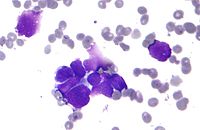
Photo from wikipedia
9002 Background: CASPIAN is an open-label, Phase 3 study of durvalumab (D) ± tremelimumab (T) + etoposide and either cisplatin or carboplatin (EP) for pts with 1L ES-SCLC. At the… Click to show full abstract
9002 Background: CASPIAN is an open-label, Phase 3 study of durvalumab (D) ± tremelimumab (T) + etoposide and either cisplatin or carboplatin (EP) for pts with 1L ES-SCLC. At the planned interim analysis (data cutoff Mar 11, 2019; 63% maturity), D + EP demonstrated a statistically significant improvement in OS compared with EP alone (HR 0.73 [95% CI 0.59–0.91]; p=0.0047). Here we present a planned updated analysis of OS for D + EP vs EP and the first results for D + T + EP vs EP. Methods: Treatment-naïve pts with ES-SCLC (WHO PS 0/1) were randomized 1:1:1 to D 1500 mg + EP q3w, D 1500 mg + T 75 mg + EP q3w, or EP q3w. In the IO arms, pts received 4 cycles of EP + D ± T, followed by maintenance D 1500 mg q4w until disease progression. Pts received one additional dose of T 75 mg post EP in the D + T + EP arm. In the EP arm, pts received up to 6 cycles of EP and optional PCI (investigator’s discretion). The two primary endpoints were OS for D + EP vs EP and for D + T + EP vs EP. Results: 268, 268 and 269 pts were randomized to D + EP, D + T + EP and EP, respectively; baseline characteristics were generally well balanced across arms. As of Jan 27, 2020, the median follow-up was 25.1 mo, 82% maturity. D + EP continued to demonstrate improvement in OS vs EP, with a HR of 0.75 (95% CI 0.62–0.91; nominal p=0.0032); median OS 12.9 vs 10.5 mo, respectively. 22.2% of pts were alive at 2 y with D + EP vs 14.4% of pts with EP. D + T + EP numerically improved OS vs EP, however this did not reach statistical significance per the prespecified statistical plan: HR 0.82 (95% CI 0.68–1.00; p=0.0451 [p≤0.0418 required for stat sig]); the median OS was 10.4 mo and 23.4% of pts were alive at 2 y. Secondary endpoints of PFS and ORR remained improved with D + EP vs EP and will be presented. Confirmed investigator-assessed ORR was similar for D + T + EP vs EP (58.4% vs 58.0%). Median PFS was similar for D + T + EP vs EP (4.9 mo vs 5.4 mo), but the 12-mo PFS rate was numerically higher (16.9% vs 5.3%); PFS HR 0.84 (95% CI 0.70–1.01). In the D + EP, D + T + EP and EP arms, respectively, incidences of all-cause AEs of Grade 3/4 were 62.3%, 70.3% and 62.8%; AEs leading to discontinuation 10.2%, 21.4% and 9.4%; and AEs leading to death 4.9%, 10.2% and 5.6%. Conclusions: The addition of durvalumab to EP continued to demonstrate improvement in OS compared with a robust control arm, further supporting this regimen as a new standard of care for 1L ES-SCLC offering the flexibility of platinum choice. No additional benefit was observed when T was combined with D + EP in this pt population. Safety findings in all arms remained consistent with the known safety profiles of all agents. Clinical trial information: NCT03043872.
Journal Title: Journal of Clinical Oncology
Year Published: 2020
Link to full text (if available)
Share on Social Media: Sign Up to like & get
recommendations!